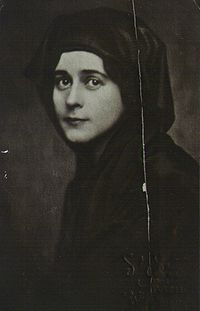- May Torok von Szendro
-
Marianne May Countess Török von Szendrö Countess May wearing an Islamic veil Spouse Arthur, Freiherr von Klingspor
Abbas Hilmi II (m. 1910; div. 1913)Full name Birth name: Marianne May
Arabic name: Djavidan Hanem
Arabic: جاويدان هانمFather József, 3rd count Török von Szendrö Mother Sofie, Gräfin Vetter von der Lilie Born 15 June 1877
Philadelphia, PA, United StatesDied 5 August 1968 (aged 91)
Graz, AustriaBurial Cemetery of St. Leonhard, Graz, Austria Occupation Pianist
Writer
Interpreter
PainterSignature Religion Sunni Islam (by conversion) May Torok von Szendro, (Philadelphia, USA 15 June 1877- Graz 5 August 1968), was a Hungarian noble, second spouse of the Khedive Abbas II of Egypt.
Contents
Background
Daughter of Sofie Countess Vetter von der Lilie and stepdaughter of Hungarian inventor Theodor Puskas. She spent most of her youth at Wassen Castle South of Graz, Austria. At age 12, she allegedly wrote short articles for various journals and played the piano. Her elder brother Count Josef Torok von Szendro (1873–98), following Austrian tradition, was enrolled at the Theresianum, were he befriended Abbas Bey, an Egyptian prince. May and Abbas met at a ball given by the Academy. Shortly thereafter, he was made ruler in Egypt. They met the second time in Paris in 1900, where they fell in love, and Abbas invited her to Egypt.
Marriage
The visit developed into a long romance culminating into a secret marriage contracted in Alexandria's Montazah Palace, witnessed by two sheiks. The official marriage took place on 28 February 1910, with the Grand Mufti of Egypt officiating. May converted to Islam in the presence of the Grand Mufti. She was then called Princess Djavidan Hanem, wife of the Khedive of Egypt. Abbas was separated from his first spouse, Ekbal Hanem, a former slave in his mother's household.
Khedive Ismail Pasha was the last ruler of Egypt to have a harem, and upon his departure, the buyuk, ortangi and cucuk harems (first, middle and third consorts), as well as the aghas (eunuchs) became out of use, and the custom at the Egyptian court had become one consort, until now. The marriage was controversial.
As consort
May accompanied the khedive on his travels to Turkey and Europe as well as inside Egypt, something unknown before. As court protocol disaprouved of women from participating in state events, May, with the complicity of her spouse, attended official receptions dressed up as a man. It was as a young palace official "dressed up in an irritating stuffy high collar and tarboosh that I accompanied the Khedive on 8 February 1909, at the laying of the final stone during the heightening of the Aswan Dam", she describes in her memoirs. On one of these occasions, forgetting she was supposed to be a man, the Khedive looked affectionately at her and asked: "Mon amour, est ce que tu n'es pas fatigée?", which shocked people standing close by.
In her own memoirs, "Harem" published in Berlin in 1930, attempts to describe the life of women in the confined inviroment of the Sultanic and Khedivial haramliks. She claimed to have an active role in the creation of Tchibukli Saray right from its drawing board, assigned and approved the landscaping of the palace gardens. As a member of the Red Cross she brought solace to victims of the first Balkan War of 1912. May entertained wives of foreign dignitaries at Mostorod Palace playing the piano. She also staged seances, which were however, stopped by Abbas.
In an article published 3 May 1928 in the Nationalzeitung, Abbas Hilmi's former Hungarian Kelemen A'rvay, describes Djavidan Hanem as: "a rare beauty and an intelligent warmhearted lady who had a soothing influence on the often petulant Khedive.", continuing: "She lived in splendor in Mostorod Palace near Matarieh. The fantastic property had a large garden and extensive agriculture domains whose revenue was assigned to her. She was the good spirit for Europeans at the Khedivial court."
Divorce
May and Abbas divorced 7 August 1913. The reason was Abbas new relationship Georgette Mesny a.k.a. Andrée de Lusange, whom he met at Maxim's in Paris the previous summer. According to Kelemen A'rvay, they returned to Egypt together. Lusange was described as :"was a 20 years old short, lean, heavily painted woman who distributed her favors for 20 francs and once in the khedive's entourage spied for the French government.", and she was also blamed for May’s departure: "It was her intrigues that pushed Djavidan Hanem to leave the palace and return to Europe."
Later life
She was given an allowance after the divorce and kept her Muslim name. She sold cosmetics in Vienna and worked as an actress in Berlin in the 1920s. She wrote radio-plays, authored several works including "Back to Paradise", "The Great Seven", "Soul And Body" and "Gulzar", and gave piano concerts.
During World War II she lived in Vienna and during the end of the war, moved to Innsbrück where she worked as an interpreter for the French Military Government in July 1945.
References
- Raafat, Samir (6 October 1994). "Queen for a Day" (Reprint). Al-Ahram Weekly. http://www.egy.com/historica/94-10-06.shtml. Retrieved 2009-07-19.[dead link]
External links
- Soszynski, Henry. "Marianne Török de Szendrö". Ancestry.com, Inc.. http://freepages.genealogy.rootsweb.ancestry.com/~royalty/islamic/i842.html#I842. Retrieved 2010-03-06.
- "Marianne May, countess Török de Szendrö". GeneAll.net. http://www.geneall.net/W/per_page.php?id=331399. Retrieved 2010-03-06.
Muhammad Ali Dynasty (1805–1953) Monarchs Consorts Heirs Ibrahim · Abbas · Sa'id · Ahmad Rifaat · Isma'il · Mustafa Fazl · Tewfik · Abbas Hilmi · Muhammad Ali Tewfik · Muhammad Abdel Moneim · Farouk · Muhammad Ali Tewfik · Ahmad FuadCategories:- 1877 births
- 1968 deaths
- Converts to Islam from Christianity
- Egyptian royal consorts
- Hungarian expatriates in Egypt
- Hungarian nobility
- Memoirists
- Morganatic spouses
- Muhammad Ali Dynasty
- People from Philadelphia, Pennsylvania
- Women of the Ottoman Empire
Wikimedia Foundation. 2010.


